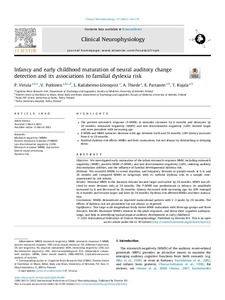Infancy and early childhood maturation of neural auditory change detection and its associations to familial dyslexia risk
Virtala Paula; Putkinen Vesa; Kailaheimo-Lönnqvist Linda; Thiede Anja; Partanen Eino; Kujala Teija
https://urn.fi/URN:NBN:fi-fe2022081154886
Tiivistelmä
Objective
We investigated early maturation of the infant mismatch response MMR, including mismatch negativity (MMN), positive MMR (P-MMR), and late discriminative negativity (LDN), indexing auditory discrimination abilities, and the influence of familial developmental dyslexia risk.
Methods
We recorded MMRs to vowel, duration, and frequency deviants in pseudo-words at 0, 6, and 28 months and compared MMRs in subgroups with vs. without dyslexia risk, in a sample over-represented by risk infants.
Results
Neonatal MMN to the duration deviant became larger and earlier by 28 months; MMN was elicited by more deviants only at 28 months. The P-MMR was predominant in infancy; its amplitude increased by 6 and decreased by 28 months; latency decreased with increasing age. An LDN emerged by 6 months and became larger and later by 28 months. Dyslexia risk affected MMRs and their maturation.
Conclusions
MMRs demonstrate an expected maturational pattern with 2–3 peaks by 28 months. The effects of dyslexia risk are prominent but not always as expected.
Significance
This large-scale longitudinal study shows MMR maturation with three age groups and three deviants. Results illuminate MMR’s relation to the adult responses, and hence their cognitive underpinnings, and help in identifying typical/atypical auditory development in early childhood.
Kokoelmat
- Rinnakkaistallenteet [27094]
